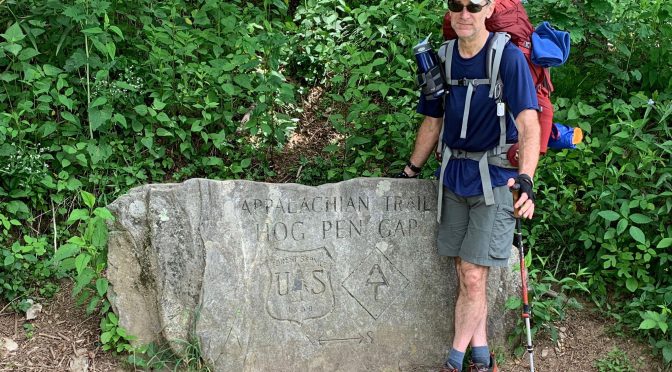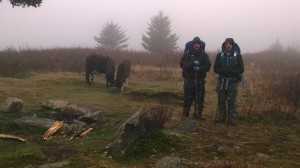An aspiring backpacker, or even one just getting into the backcountry, would find a lot to like about Henry Perangelo. He pays attention to, but isn’t obsessed with weight: “I can’t seem to get my pack much below 32, 33 pounds.” Same with gear: he appreciates a thing that does its job, but can’t remember the names of most of his gear (asked about his shoes, he replies, “They’re red and gray; I think they start with an M … .”). And when it comes to food, Henry is pretty much a freeze-dried, eat-from-the-bag kind of guy (“The one that starts with an M, I like their spaghetti and meatballs. Which tastes a lot like their lasagna”).
Tag Archives: section hike
Finding your way, when your way is buried in snow
Trail blazes painted on rocks are a necessity where there are no trees.
And that’s fine — until those blazes are buried beneath a foot of snow.
A freak early-season winter storm the first weekend in November that dumped up to 22 inches in the high country may have gotten the 2014-15 Southeast ski season off to a great start, but it presented a challenge to backpackers surprised by the intensity of the storm, especially those making their way on the Appalachian Trail through the Mount Rogers/Grayson Highlands area of southwest Virginia, known for its vast exposure.
“We got lost twice,” says Greg Carpenter, 50, of Greensboro, “the first time for 30 minutes, the second for about 15.” As seasoned AT section
hikers, though, it would take more than tromping in white-out conditions in knee-deep snow to get them off-track for long.
Todd Isenhour, who is 52, and 56-year-old Mike Baptist began section-hiking the AT last October. Carpenter joined them in February. They try to hike a 60-or-so-mile segment of the AT once a month, typically over four days.
The three left after work on Wednesday, Oct. 29, and drove to Damascus, Va., where they’d ended their September hike.
“We saw there was snow in the forecast, eight to 12 inches, so we decided to drop one car at the 48-mile mark and one at 65 miles,” where they intended to stop. The bail-out vehicle would prove to be a smart move.
Thursday’s hike was in sunshine. On Friday, it started snowing around 11 a.m.
“It was coming down white,” Carpenter says.
They were in one of the worst areas to be caught in heavy snow: the high meadows where the trail is followed primarily by the trough it forms. It wasn’t long before the heavy snow filled in the trough.
“We’d wander off, then find our way back by feeling for the trail.”
Even when the trail reentered a forested area, they were handicapped: the blowing snow was sticking to the tree trunks, covering those blazes.
“We’d lose the trail, then fan out and start wiping off the trees until we’d find a blaze,” says Carpenter.
Veterans of AT shelters by this point in their section hiking, when they reached the Raccoon Branch shelter a little after 4 that afternoon, they put up a tarp to keep out the blowing snow.
Based on the forecast, had they packed additional gear and equipment for the conditions?
“No, because we always take what we need,” says Carpenter. While his partners’ packs were both around 30 pounds, Carpenter says his weighed in at 40.
“I like to take things,” Carpenter says. Like battery-powered Christmas lights, to spruce up the campsite.
They each had sleeping bags rated to 20 degrees, each had adequate winter clothing (Carpenter packed five pairs of socks for a four-day trip — and extra underwear), and each brought their own tent in case the shelters were full.
Carpenter said the three usually hike at their own pace and often don’t see one another for long stretches. When they hit the snowy trail Saturday, they stayed together.
“To be honest, I was scared of getting lost,” says Carpenter.
The snow was taking its toll in other ways. Despite having cold weather gear, the strenuous hiking generated a good deal of sweat — and as a result, chaffing.
“I had things bleeding on me that shouldn’t be bleeding on a man,” says Carpenter.
In the end, though, the buried trail won out. After a challenging day of fits and starts, they decided to take advantage of the bail-out vehicle stashed at the 48-mile mark.
That next 12 miles could wait for another, less snowy, day.
* * *
Explore further
For more tips on hiking and backpacking in snow, check out the “AMC Guide to Winter Hiking & Camping,” ($16.95, Appalachian Mountain Club), a comprehensive guide to all aspects of winter exploring.
The right gear is critical for surviving a wintry trail. Learn just what gear is critical at “Essential Winter Gear for Northeastern Hikes,” on the Appalachian Mountain Club website (the information is culled from the aforementioned “AMC Guide to Winter Hiking & Camping”).

